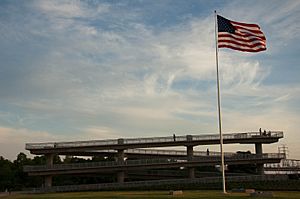Malcolm W. Martin Memorial Park facts for kids
Quick facts for kids Malcolm W. Martin Memorial Park |
|
|---|---|
 |
|
| Lua error in Module:Location_map at line 420: attempt to index field 'wikibase' (a nil value). | |
| Location | East St. Louis, Illinois, United States |
| Area | 31.4 acres (12.7 ha) |
| Parking | On site, south side. |
| Facilities | Gateway Arch viewpoint and Mississippi River Overlook; Gateway Geyser |
| Website | Metro East Park and Recreation District |
Malcolm W. Martin Memorial Park is a cool park located in East St. Louis, Illinois. It's right across the Mississippi River from the famous Gateway Arch and the city of St. Louis, Missouri. The most exciting part of the park is the Gateway Geyser. This amazing fountain shoots water super high, up to 630 feet (about 192 meters) into the air! It's like a water version of the Gateway Arch, and you can see it clearly from St. Louis.
Around the big geyser, there are four smaller fountains. They represent the four rivers that meet near St. Louis: the Mississippi, Missouri, Illinois, and Meramec Rivers. The park also has a special viewing spot where you can look out over the river and the St. Louis skyline.
Contents
History of the Park
The Big Idea
The person who designed the Gateway Arch, Eero Saarinen, imagined a memorial that would reach both sides of the Mississippi River. However, there wasn't enough money to build something on the Illinois side at first. The big Gateway Arch National Park (which was called the Jefferson National Expansion Memorial back then) was built in St. Louis, with the Arch as its main part.
One of the people who strongly supported building the Arch in 1947 was a lawyer from St. Louis named Malcolm W. Martin. After 20 years passed with nothing built on the Illinois side, Martin decided to take action. In 1968, he started a group called the Gateway Center of Metropolitan St. Louis. Their goal was to buy land for a park on the Illinois side. In 1987, he led a special committee to plan the park's design. He even won an award for his hard work the next year!
Malcolm W. Martin had an interesting life. He studied law in St. Louis after graduating from Yale. During World War II, he went to Europe and helped with the Normandy D-Day invasion. When he came back to St. Louis, he became very involved in his community. He was part of the St. Louis Board of Education and even helped start the local PBS TV station.
Making the Park Real
Work on the park began with putting up a 100-foot (30 meter) flagpole. This happened soon after Malcolm Martin's group bought the land from the Illinois Central Railroad. The Gateway Geyser fountain first shot water into the sky on May 27, 1995, with Malcolm Martin himself flipping the switch!
When Malcolm Martin passed away in 2004, he left $5 million to help finish the park. This money was used to build the Mississippi River Overlook and complete the rest of the park. On June 17, 2005, the park's ownership was given to the Metro East Park and Recreation District. The park officially opened to the public in June 2009. Malcolm Martin's original group, Gateway Center, still helps pay for the park, but the Metro East Park and Recreation District now owns and takes care of it.
Park Features
Malcolm W. Martin Memorial Park has many cool things to see and do:
- Gateway Geyser: The giant water fountain that shoots water super high.
- Mississippi River Overlook: A special platform where you can get amazing views.
- Malcolm W. Martin Statue: A statue of the man who helped make the park possible.
- Web camera: You can even see the park live online!
- Green space and concrete paths: Perfect for walking and relaxing.
- Benches: Places to sit and enjoy the views.
- Free parking lot: Easy to visit by car.
- 24-hour security station: To keep everyone safe.
The overlook platform gives you fantastic views of the St. Louis Arch, the city skyline, the Mississippi River, and the Gateway Geyser. It officially opened on June 6, 2009.
The Gateway Geyser usually erupts once every day from May 1st to September 30th. Each eruption lasts for 10 minutes. However, it depends on the wind, weather, and if there's a drought. The geyser takes a break and doesn't run from October through April.
How the Geyser Works
The Gateway Geyser was designed and built by a company from St. Louis called Hydro Dramatics. Three powerful 800-horsepower (600 kW) pumps make the fountain work. These pumps push out 7,500 gallons of water every minute (about 50 liters per second)! The water shoots out of a 6-foot (about 2 meter) tall nozzle at a very high pressure.
The four smaller fountains around the main geyser use smaller 125-horsepower pumps. Each of these fountains gets its water from a large 8-acre (3.2 hectare) lake that holds a million gallons of water. The Gateway Geyser also has a smart electronic system. It automatically shuts down if the winds get too strong, over 13 miles per hour (20.9 km/hr), to keep everything safe.
The Overlook is a walkway that goes up in five steps. It ends at a platform that is 40 feet (about 12 meters) above the river bank. It's made of strong concrete and steel, and has lighted railings for safety. A bronze statue of Malcolm Martin sits at the top, looking out at the Gateway Arch, which he worked so hard to protect. A live web camera is also there, so people can always see the view. The statue was created by a St. Louis artist named Harry Weber.
Images for kids





